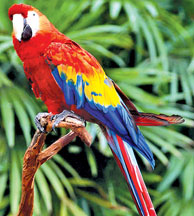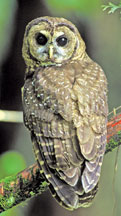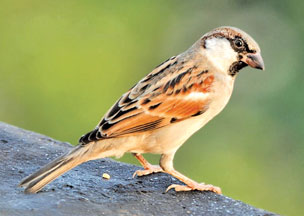Bird lore in Lanka's culture
by Andrew Scott
From time immemorial Sri Lankan villagers who usually made their
living as farmers always came in direct contact with nature, especially
wild animals, about whom there developed a large store of superstitious
stories, sayings and beliefs some of which are also rich in humour. Most
of the wild animals were friends of the villagers and a few were their
foes.
 |
|
Parrot |
|
 |
|
Owl |
From their ancestry the Sri Lankan villagers were strong believers of
the principle of transmigration and devil worship; and the beliefs and
observations of the habits and special features of wild animals
especially of the fauna of the country, increased immensely as a result
of which many legends came into existence. Some of the bird lore which
are still prevalent in far away villages in Sri Lanka are both
interesting and humorous and some contain a tinge of philosophy.
The house sparrow (Ge kurulla) is a little lovable bird whose habits
have been under close observation for quite a long time. Sri Lankan bird
lore tells us how the black patch on the male bird's throat came into
being. It tells us that a house under the eaves of which a pair of these
birds had built their nest and was nursing their young ones caught fire.
The female bird had run away in fright while the cock-bird had fought
bravely to save its young one from the flames. In this brave act the
male bird is said to have burnt its throat and the mark that testifies
to the bravery and the paternal love of the bird still remains as a
black patch on its throat.
The breeding of sparrows in houses is considered to bring good luck
and to encourage the birds to build nests in human dwellings people
place damaged old pots on their walls. There is yet another strong
belief that if a sparrow builds a nest in a house and begins to rear its
young in that building the owner would be blessed with children. It is
also said that house sparrow eggs are used to charm objectionable
tom-tom beating whereby the collapse of the instrument is caused.
The domestic fowl or hen (Kukula or Kikili) has been a household bird
from time immemorial. A very common village saying connected with the
domestic fowl is Kukula andalana kota negitinne (wake up when the cock
crows).
Villagers believe that a white cock would bring happiness and luck
and is, therefore, lovingly reared in homes and even in some temples. It
is also a bird which has served the purpose of an alarm especially in
ancient Sri Lanka. It is considered a good omen if a cock crows when one
is to set out on an important journey.
|
 |
|
House sparrow |
The owl (Bakamuna) is considered as a very unlucky bird and there are
several stories and beliefs about it. In the villages people believe
that its hooting will bring about a sudden death to someone in the
village. It is also said that some parts of its body are used in black
magic or huniyan and that the bark of the tree taken off while the owl
is on the tree and before it has finished screeching, is also used for
charming purposes.
Devil bird
The devil bird (Ulama) named after its haunting cry, remains a
mystery. Those living in the neighbourhood of thick jungles consider it
to be a bird of terror and ill-omen and little children shiver at its
spine-chilling cry. Many believe that the cry of the devil bird is such
an ill-omen that it will be surely followed by a sudden death of
someone. The parrot (Girava) of which there are several varieties in Sri
Lanka, has been immortalised in the Jataka stories.
Some attribute the powers of speech of the parrots to a unique honour
bestowed on them by the Buddha himself in a previous birth. The crow
(Kaputa or Kaakka) is also a very common bird about which there are many
beliefs and it features in several Sinhala folk tales. One strong belief
is that a crow's cawing near a human dwelling announces the imminent
arrival of some unexpected visitor.
The common babbler (Demalichcha) has perhaps got its name from the
resemblance of a group of these birds to a band of noisy Tamils. The
magpie robin known both as Polkichcha (coconut bird) as well as
Pahan-Kichcha (Dawn bird) is observed to sing in the early morning and
late evening. Usually it has a melodious voice and sometimes emits a low
ominous sound as a result of which villagers have established it to be a
bird of ill-omen.
Even town folk consider the magpie robin with a certain amount of
horror mingled with superstition. This bird is believed to be an
incarnation of Huniyan Yaka and its voice especially the ominous
singing, is believed to announce bad news and is considered a message of
misfortune and death. If this bird builds its nest in homes, villagers
consider it the greatest misfortune and usually chase it away from the
neighbourhood of their dwellings.
Maha Sohona
The black robin (Kalu Polkichcha) is believed to be an incarnation of
a devil, Maha Sohona, and it is said that this bird's body is used by
the villagers in the preparation of charms.
 |
|
Magpie robin |
Another bird, the Indian Koel (Koha) has earned the admiration of the
villagers by its loud, musical voice. The paradise flycatcher popularly
known as Gini Hora (fire thief), Kapu Hora (cotton thief) or Redi hora
(cloth thief) is considered to be transmigrated representatives of human
beings who have been dishonest and the colour (red or white) of the
birds is believed to depict the colour of the articles that had been
stolen.
The spotted dove (Kobeiya) is a bird whose somewhat mournful voice
has attracted the attention of the Sinhala villagers from time
immemorial. There is a widespread legend among them which accounts for
the mournful voice of this bird.
It says this bird is the reincarnation of a wicked woman who had
killed her own child and up to this day the bird goes round the world
lamenting for her dead son. The pond heron (Koka) or the night heron
(Kana Koka) is known for its cry at night which is believed to be an
ill-omen and that if the bird cries while in flight over a house it is a
sure warning that death will come soon to an inmate of the house. There
are many Sinhala sayings about the Koka too.
It is interesting to recall that some of the well-known Sinhala poems
are written in the form of messages or Sandesayas which the poets
imagined to entrust to some bird to deliver safely.
The following are some of these popular Sandesayas, most of which
begin with a rich poetic description of the bird entrusted with the
delivery of the message. Mayura Sandesaya (Peacok's message), Selalihini
Sandesaya (Grackle's message), Paravi Sandesaya (Pigeon's message),
Tisara Sandesaya (Swan's Message), Savul Sandesaya (Cock's message) and
Gira Sandesaya (Parrot's message).
|



